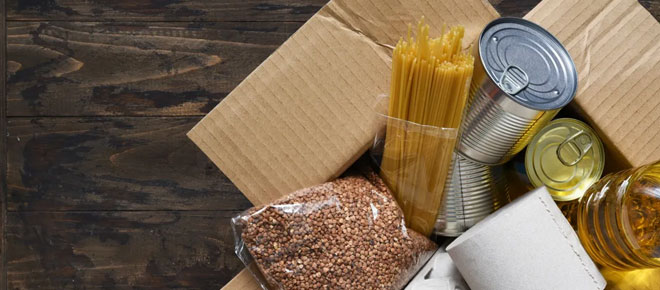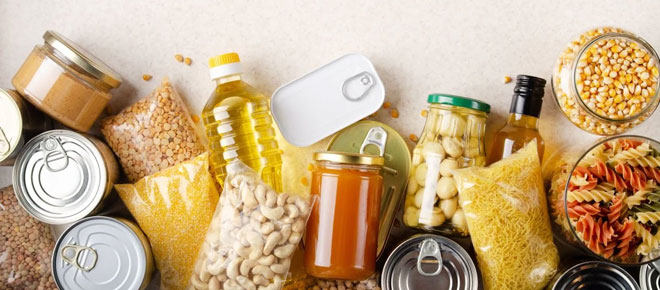Top 6 Survival Foods You Need in Your Emergency Kit

In case of emergency situations, having a stockpile of survival foods is crucial. These top 6 survival foods include canned fruits and vegetables, dried beans and grains, peanut butter, canned meats and fish, energy bars, and powdered milk. These non-perishable items are easy to store, provide essential nutrients, and have a long shelf life. Make sure to keep them in your emergency kit to ensure you have enough sustenance during a crisis.
Dried Beans
The survival foods preppers rely on must be able to last for a long time, and few foods last as long as dried beans. They are a staple food that is easily rehydrated in the event of a disaster, and they offer high amounts of protein, fiber, and potassium, as well as many vitamins and minerals.
Beans, peas, and lentils (also known as legumes) are one of the oldest cultivated crops around, with evidence of cultivation dating back 7,000 years. They are a versatile food that provides a good source of protein, dietary fiber, complex carbohydrates, and iron, and can be eaten raw or cooked. Beans, peas, and lentils also grow well in a wide variety of climates, which is important for a survival crop.
Dried beans can be stored in a container for up to five years and are an excellent survival food to keep in your emergency kit. They are a nutritious option that can be boiled, added to soups and stews, or mixed with meat to make a hearty meal.
It’s recommended that your emergency kit contains a several-day supply of nonperishable food and includes a manual can opener and eating utensils. FEMA recommends that you choose a variety of foods your family will enjoy and select items that can be prepared with water, without refrigeration or cooking.
Canned Food
Canned foods like beans, soups, and even some fruits and vegetables make a great staple for emergency food storage. You can also get canned meats which will provide a good source of protein if you don’t have access to fresh sources. Eggs are another high-protein, non-perishable option to consider. Canned milk is another way to add calcium-rich foods to your survival stockpile. However, canned foods can also have some disadvantages, such as high sodium content, low fiber content, and potential exposure to BPA. If you want to avoid these risks and enjoy more nutritious and delicious food in an emergency situation, you might want to use the Valley Food Storage Promo, which can help you get a great deal on freeze-dried and dehydrated food that has a long shelf life, no preservatives, and natural ingredients. You can find the promo code on the [Saving Gain website], where you can also browse through their selection of meals, snacks, drinks, and supplies.
One of the best things about canned foods is that they don’t need to be refrigerated, and many cans have easy-to-open metal lids. This means you can keep your canned food in a backpack or bag and take it out on any outdoor adventure. Canned food is also an ideal go-to for camping and hiking as it can be prepared in just a few minutes without needing to bring any other cooking supplies. Canned food is a good choice for survival foods as it has been processed to ensure it stays safe for long periods. The canning process allows them to be heated at just the right temperature to kill off any pathogens. This process also keeps the nutritional content of canned foods at their highest levels.
You can find canned foods with a shelf life of up to 30 years, so they are an excellent addition to any emergency supply. When shopping for canned foods, be sure to buy the thick, metallic #10 cans as they will hold up better against moisture and rust than other types of containers.
Lard
One of the oldest and most trusted culinary fats, lard is an excellent addition to any survival food kit. It’s a solid rendered fat that comes from the fat pads of pigs. You can make it at home by steaming the pork fat or cooking it down in a kettle. You can also purchase it at grocery stores, but it’s usually much cheaper to make your own.
It has a very high melting point, which means that it can be used for making bacon or frying vegetables and potatoes. You can also use it for making homemade soap, shaving cream, and even as a moisturizer for your skin. If you’re going to stockpile lard, it’s best to get it from a source that has been raised humanely.
Another advantage of lard is that it can keep your lips moisturized, which will be important if you’re spending long periods outdoors in a survival situation. It can also be used as a substitute for lip balm, so it’s worth having some on hand in case your normal lip care products run out.
Salt
Salt is an important survival food for many reasons. It adds flavor to foods, and it is essential for human health. Salt helps to regulate blood pressure and balance electrolytes. It is also a natural preservative. Salt is even used to cure meats because it has an osmotic effect on bacteria, keeping them from spoiling your food.
Another important reason to include salt in your emergency kit is that it can help you treat a sore throat. Mixing a teaspoon of salt with warm water and gargling several times a day can provide relief from a sore throat and prevent bacteria from spreading in your mouth. Salt is also a good addition to your survival kit because it can be used to create an effective saline solution for cleaning wounds.
Food & Drinks Discount Codes are a great way to save money on your emergency food supplies, as well as to enjoy some delicious and satisfying meals in a crisis situation. While the bulk of your emergency kit should consist of long-lasting canned foods, it is also a good idea to include some calorically-dense comfort foods like mac and cheese, casseroles, soups, and chili. Canned fruit can also be a great addition to your emergency supplies, as these foods are low in sodium and have a lot of nutrients. If you are looking for a high-calorie survival snack that is not too difficult to store, look for emergency ration bars, such as these from SOS Food Labs, which come in vacuum-sealed packages. These bars are coconut-flavored with a cookie-like texture and contain enough calories to keep you going in an emergency.
Sugar
In a survival situation, sugar is an important food to have in your emergency kit. It is a great source of energy and can help you stay hydrated. It also helps keep your body from going into a hypoglycemic state, which can be very dangerous in a survival situation. It is easy to store and will last for a long time when it’s stored properly.
Other sweet foods are also important for an emergency kit, such as granola bars or dehydrated fruits. These snacks are easy to store and provide you with a lot of calories to fuel your body. If you’re looking for something with more protein, consider jerky or freeze-dried meat. These foods are typically high in protein and can give you a healthy boost of energy.
Salt is another survival food that’s a must-have. It’s used for storing, curing beef, and flavoring most meals. It’s one of the most affordable and tastiest items you can add to your emergency kit.
During an emergency, you’ll need to think of meeting basic needs more than your own preferences and tastes. That’s why it’s best to stick with foods that are long-lasting and taste good. By adding these 10 survival foods to your emergency kit, you’ll be prepared for anything that might happen. Just remember to replenish your supply often.
Tea Bags
During an emergency, tea bags are great for adding flavor to bland meals and are easy to use in a cup or mug. They're also good for soothing a stinging sensation after an injection or needle stick, as well as helping reduce fever. Tea is also a great drink to keep you hydrated.
Keeping food and water on hand is especially important during a disaster, as humans need to be more than 60% water. When looking for survival foods, make sure you're getting food with a long shelf-life that won't spoil easily. Most products today have a shelf-life of anywhere from five to 30 years. However, not all survival food products are created equal. Some of them may have low-quality ingredients, high sodium content, or artificial flavors and preservatives. If you want to get the best value and quality for your money, you might want to use the Coupon Rie Promo Code, which can help you save up to 50% on premium survival food kits from various brands and categories. You can find the code on the [Coupon Rie website], where you can also read customer reviews and ratings of different products. Look for kits that offer a mix of entrees, sides, and snacks so that you don't get bored with one type of food during an extended emergency.
You should also store non-perishables in your kit, like canned tuna fish, granola bars, crackers, and meat jerky. These can provide a quick meal or a snack for kids and adults alike, and they're an excellent way to meet your daily protein needs.
The CDC and Red Cross recommend storing a few days' worth of non-perishables, including canned foods and dry mixes, as well as a manual can opener, eating utensils, and blankets. They also suggest a first-aid kit with a supply of bandages, antiseptic wipes, and basic tools. Be sure to keep a radio that will continue to work during an emergency on hand as well.
Conclusion
Having a well-stocked emergency kit is crucial in times of crisis. Including these six survival foods can ensure you have the necessary nutrients and energy to survive. From canned meats to energy bars, these foods provide a long shelf life and require little to no preparation. Don't wait until it's too late; start putting together your emergency kit right away.









